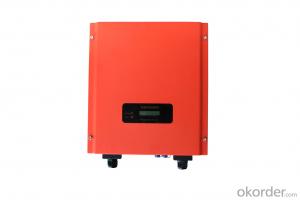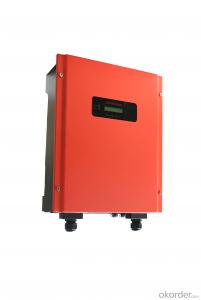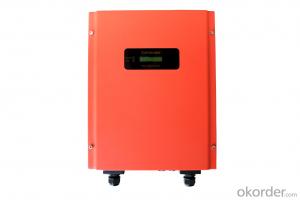PV Inverter Sunteams 1500-3000
- Loading Port:
- China Main Port
- Payment Terms:
- TT OR LC
- Min Order Qty:
- -
- Supply Capability:
- -
OKorder Service Pledge
OKorder Financial Service
You Might Also Like
The Sunteams 1500 ~5000 series isapplicable to various rooftops and small scale photovoltaic grid-connectedpower plants. Their nominal output powers are 1.5 kW, 2 kW, 2.5 kW, 3 kW, 3.6 kW, 4 kW and 5kW respectively.
This series is transformerless and has a wide range of MPPT input voltage. Itsmaximum conversion efficiency and MPPT tracking accuracy reach 97.6 % and 99.5% respectively. The maximum DC voltage reaches 550 V. Its multilingualLCD display facilitates easy operation. It has waterproof direct plug interminals. It has overvoltage, islanding, short circuit, overloading andoverheating protection functions. Its IP65 protection degree will ensure itruns well in various tough environments.
These units are available with or without wirebox.
- Q:What is the role of a bypass switch in a solar inverter?
- The role of a bypass switch in a solar inverter is to provide a means for redirecting the flow of electricity in case of an emergency or failure within the inverter. It allows for the direct connection of the solar panels to the utility grid, bypassing the inverter, ensuring a continuous supply of electricity even when the inverter is not functioning properly. This helps maintain the stability and reliability of the solar power system.
- Q:What is the power factor of a solar inverter?
- The power factor of a solar inverter typically refers to the ratio of the real power to the apparent power consumed by the inverter. It represents the efficiency of the inverter in converting DC power from the solar panels into AC power for use in the electrical grid. A high power factor indicates a more efficient inverter that minimizes reactive power losses.
- Q:Can a solar inverter be used in regions with high humidity or moisture levels?
- Yes, solar inverters can be used in regions with high humidity or moisture levels. However, it is important to ensure that the inverter is designed and rated for such conditions. The inverter should have adequate protection against moisture, such as being IP65 rated or higher, to prevent any damage or malfunctions due to humidity or moisture.
- Q:What are the potential risks of overheating a solar inverter?
- The potential risks of overheating a solar inverter include reduced efficiency and performance, increased wear and tear on components, shortened lifespan of the inverter, potential damage to internal circuitry, and even the risk of fire.
- Q:Can a solar inverter be used with concentrated solar power systems?
- Yes, a solar inverter can be used with concentrated solar power systems. Concentrated solar power (CSP) systems use mirrors or lenses to concentrate sunlight onto a receiver, which then converts the sunlight into heat. This heat can then be used to generate electricity through various means, including steam turbines. In order to convert this heat-generated electricity into the required alternating current (AC) for use in homes and businesses, a solar inverter is needed. Therefore, a solar inverter is an essential component in connecting and integrating the electricity generated by concentrated solar power systems into the power grid.
- Q:What are the key factors affecting the reliability of a solar inverter?
- The key factors affecting the reliability of a solar inverter include the quality and durability of its components, such as the semiconductor devices, capacitors, and transformers. The design and manufacturing processes also play a significant role, as well as the overall system integration and installation. The environmental conditions, such as temperature, humidity, and dust levels, can impact the inverter's reliability, along with the quality of the electrical grid and the stability of the solar power generation. Regular maintenance and monitoring are crucial for identifying and addressing any potential issues that may arise, ensuring the long-term reliability of the solar inverter.
- Q:Can a solar inverter be used with a time-of-use electricity tariff?
- Yes, a solar inverter can be used with a time-of-use electricity tariff. Time-of-use electricity tariffs typically involve different rates for electricity consumption based on the time of day. A solar inverter can be programmed to produce and export excess solar energy during peak times when electricity rates are higher, and import energy from the grid during off-peak times when rates are lower. This allows users to optimize their energy consumption and potentially save on electricity costs.
- Q:Can a solar inverter be integrated with a smart home system?
- Yes, a solar inverter can be integrated with a smart home system. By connecting the solar inverter to the smart home system, users can monitor and control their solar energy production and consumption remotely. This integration allows for better energy management, optimizing the use of solar power, and potentially saving on electricity bills.
- Q:Can a solar inverter be used in a solar-powered data center?
- Yes, a solar inverter can be used in a solar-powered data center. A solar inverter is an essential component of a solar power system that converts the direct current (DC) produced by solar panels into alternating current (AC) electricity, which is suitable for use in powering electronic equipment such as servers and data centers. By using a solar inverter, a solar-powered data center can efficiently utilize the electricity generated by solar panels, reducing its reliance on traditional grid power sources and promoting sustainability.
- Q:Can a solar inverter be used in areas with high levels of electrical noise or interference?
- Yes, a solar inverter can be used in areas with high levels of electrical noise or interference. However, it is important to ensure that the inverter is designed to handle such conditions and has appropriate noise filtering mechanisms in place to minimize any potential disruptions or damage caused by the interference.
1. Manufacturer Overview |
|
|---|---|
| Location | |
| Year Established | |
| Annual Output Value | |
| Main Markets | |
| Company Certifications | |
2. Manufacturer Certificates |
|
|---|---|
| a) Certification Name | |
| Range | |
| Reference | |
| Validity Period | |
3. Manufacturer Capability |
|
|---|---|
| a)Trade Capacity | |
| Nearest Port | |
| Export Percentage | |
| No.of Employees in Trade Department | |
| Language Spoken: | |
| b)Factory Information | |
| Factory Size: | |
| No. of Production Lines | |
| Contract Manufacturing | |
| Product Price Range | |
Send your message to us
PV Inverter Sunteams 1500-3000
- Loading Port:
- China Main Port
- Payment Terms:
- TT OR LC
- Min Order Qty:
- -
- Supply Capability:
- -
OKorder Service Pledge
OKorder Financial Service
Similar products
New products
Hot products
Hot Searches
Related keywords































